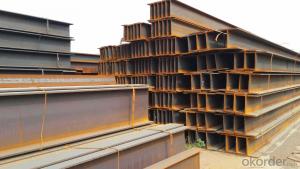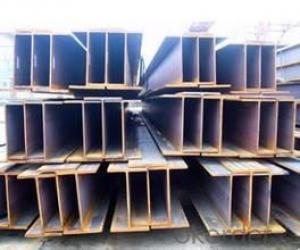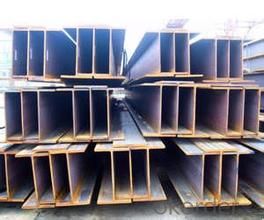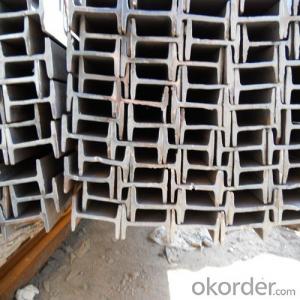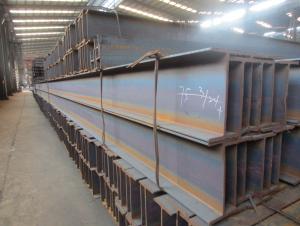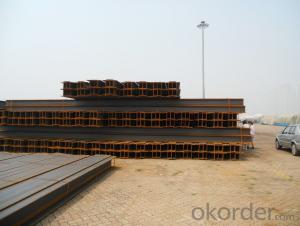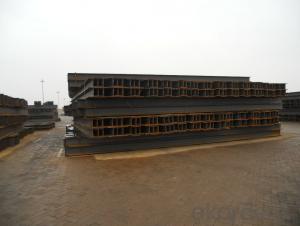Carbon steel H BEAM for construction JIS SS400
- Loading Port:
- Tianjin
- Payment Terms:
- TT or LC
- Min Order Qty:
- 25 m.t.
- Supply Capability:
- 100000 m.t./month
OKorder Service Pledge
OKorder Financial Service
You Might Also Like
Product Description:
OKorder is offering carbon steel H BEAM for construction JIS SS400 at great prices with worldwide shipping. Our supplier is a world-class manufacturer of steel, with our products utilized the world over. OKorder annually supplies products to European, North American and Asian markets. We provide quotations within 24 hours of receiving an inquiry and guarantee competitive prices.
Product Applications:
Carbon steel H BEAM are ideal for structural applications and are widely used in the construction of buildings and bridges, and the manufacturing, petrochemical, and transportation industries.
Product Advantages:
OKorder's H Beam are durable, strong, and resist corrosion.
Main Product Features:
· Premium quality
· Prompt delivery & seaworthy packing (30 days after receiving deposit)
· Corrosion resistance
· Can be recycled and reused
· Mill test certification
· Professional Service
· Competitive pricing
Product Specifications:
1. Standard: JIS 3192
2. Grade: SS400 or Equivalent
3. Length: 10m, 12m as following table
4. Invoicing on theoretical weight or actual weight as customer request
5.Payment: TT or L/C
Size and Mass of H beam:
| Size (mm) | Mass (Kg/m) | Size (mm) | Mass (Kg) |
| 198*99*4.5 | 17.8 | 194*150*6 | 29.9 |
| 200*100*5.5 | 20.9 | 200*200*8 | 49.9 |
FAQ:
Q1: How soon can we receive the product after purchase?
A1: Within three days of placing an order, we will begin production. The specific shipping date is dependent upon international and government factors, but is typically 7 to 10 workdays.
Q2: Can stainless steel rust?
A2: Stainless does not "rust" as you think of regular steel rusting with a red oxide on the surface that flakes off. If you see red rust it is probably due to some iron particles that have contaminated the surface of the stainless steel and it is these iron particles that are rusting. Look at the source of the rusting and see if you can remove it from the surface.
Images:
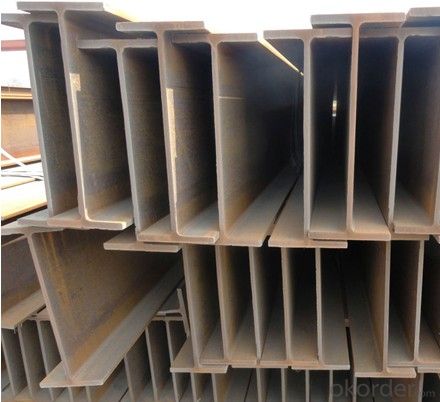
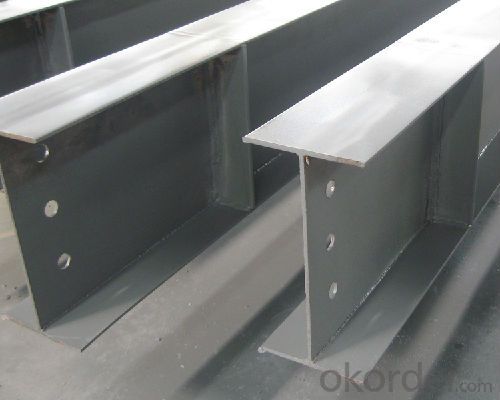
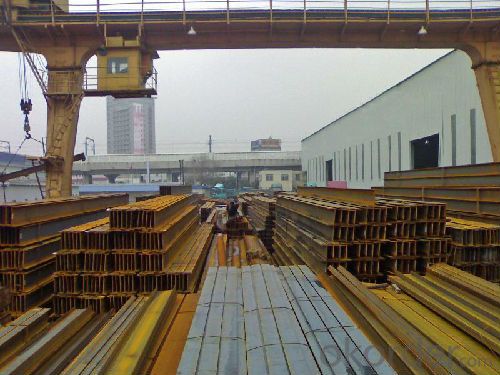
- Q: How do steel H-beams contribute to the overall sustainability of a transportation hub?
- Steel H-beams contribute to the overall sustainability of a transportation hub in several ways. Firstly, they are a durable and long-lasting structural element, ensuring the longevity of the infrastructure. This reduces the need for frequent repairs or replacements, thereby minimizing resource consumption and waste generation. Additionally, steel H-beams have a high strength-to-weight ratio, allowing for efficient and lightweight construction, which reduces the overall material and energy requirements during the construction process. Furthermore, steel is a highly recyclable material, making it easy to recover and reuse at the end of its service life, promoting a circular economy. Overall, the use of steel H-beams in a transportation hub enhances its sustainability by providing a robust, efficient, and environmentally friendly infrastructure solution.
- Q: Can steel H-beams be used for shopping malls or retail complexes?
- Yes, steel H-beams can be used for shopping malls or retail complexes. Steel H-beams provide structural support and stability, making them suitable for large-scale commercial buildings like shopping malls or retail complexes. They offer the necessary strength and flexibility to accommodate various architectural designs and layouts required in such establishments. Additionally, steel H-beams are durable, fire-resistant, and can withstand heavy loads, making them a practical choice for these types of structures.
- Q: What are the different surface finishes available for steel H-beams?
- Some common surface finishes available for steel H-beams include black oxide, galvanized, painted, and powder coated. These finishes serve different purposes such as enhancing corrosion resistance, improving aesthetics, or providing a protective coating.
- Q: What is the load-bearing capacity of H steel spans 6 meters and 300 * 300? How is it calculated?
- You said the H section steel belongs to the middle wing H section steel, the national standard has 294*200*9*12 specification.
- Q: Are steel H-beams resistant to termites or other pests?
- Yes, steel H-beams are resistant to termites and other pests.
- Q: Can steel H-beams be used in marine environments?
- Steel H-beams are suitable for marine environments, but they need to be protected and maintained to prevent corrosion. Marine environments are known for their high moisture levels, exposure to saltwater, and harsh weather conditions, all of which can speed up the corrosion process of steel. To reduce these risks, steel H-beams used in marine environments should be constructed from corrosion-resistant materials like stainless steel or galvanized steel. Stainless steel is particularly well-suited for marine environments because of its strong resistance to corrosion and rust. It contains a significant amount of chromium, which develops a thin, passive layer on the surface of the steel, shielding it from the corrosive effects of saltwater and moisture. Stainless steel H-beams can withstand the tough marine environment without significant deterioration, making them a popular choice for piers, bridges, and offshore structures. Galvanized steel is another viable option for marine environments. It is carbon steel that has been coated with a layer of zinc, acting as a sacrificial barrier against corrosion. The zinc coating corrodes first, protecting the underlying steel from direct exposure to saltwater and moisture. However, galvanized steel may not be as long-lasting as stainless steel in highly corrosive marine environments, and the protective zinc coating can wear off over time, necessitating periodic maintenance and reapplication of the coating. Regardless of the steel type used, regular maintenance and inspections are crucial to ensure the integrity of H-beams in marine environments. This involves regular cleaning to eliminate salt deposits, repainting or re-galvanizing as necessary, and promptly addressing any indications of corrosion or damage. Additionally, proper design considerations should be taken into account to accommodate the specific challenges presented by marine environments, such as tidal forces, wave impact, and temperature fluctuations. In conclusion, steel H-beams can be used in marine environments if they are made from corrosion-resistant materials like stainless steel or galvanized steel and are adequately maintained. With the appropriate precautions, these beams can endure the harsh conditions of marine environments, making them a dependable choice for various marine structures and applications.
- Q: What are the different methods of protecting steel H-beams from corrosion?
- There are multiple options available for safeguarding steel H-beams against corrosion. 1. Galvanization provides a protective layer of zinc coating on the steel beams. This zinc layer acts sacrificially, corroding first to shield the steel from oxidation. Galvanized steel beams exhibit exceptional resistance to corrosion and can endure harsh environments. 2. Another approach is to apply a protective paint coating to steel H-beams. This creates a physical barrier between the steel and the surroundings, preventing moisture and oxygen from reaching the metal surface. Regular maintenance and periodic repainting may be necessary for long-term protection. 3. Epoxy coatings are commonly employed in industrial settings to safeguard steel beams from corrosion. These coatings create a robust and durable barrier that withstands moisture, chemicals, and UV radiation. Various thicknesses of epoxy coatings can be utilized to meet specific requirements. 4. Powder coating involves the application of dry powder to the steel beams, which is then heated and fused to form a protective layer. This method provides a durable, chip-resistant coating that delivers excellent corrosion protection. Powder coatings are available in a diverse range of colors and finishes. 5. Cathodic protection entails connecting the steel H-beams to a sacrificial anode, like zinc or magnesium, through an electrical circuit. By sacrificing themselves, the anodes corrode instead of the steel beams, effectively preserving them from oxidation. Cathodic protection finds frequent usage in marine environments or structures buried in soil. 6. Vapor corrosion inhibitors (VCI) incorporate special packaging materials that release protective vapors. These vapors form a molecular layer on the steel surface, thwarting corrosion. VCI methods are commonly employed for protecting steel H-beams during shipping and storage. It is crucial to consider the specific application, environmental conditions, and budgetary constraints when selecting the most appropriate method for safeguarding steel H-beams against corrosion.
- Q: What are the different types of steel H-beam profiles?
- Different purposes and applications call for various types of steel H-beam profiles. Let's explore some of the common ones: 1. The standard H-beam is widely used due to its wide flange and tapered web, which make it suitable for different structural applications. 2. The wide flange (W) beam offers enhanced stability and load-bearing capacity with its wider flange. It is commonly employed in construction projects that demand robust support beams. 3. The American standard beam (S), also known as S-beams, features a narrower flange and thinner web compared to standard H-beams. These are commonly utilized in smaller-scale construction projects. 4. The European standard beam (HEA/HEB/HEM) adheres to European standards and has a wider flange than standard H-beams. It finds common application in construction projects across Europe. 5. The Japanese standard beam (JIS) conforms to Japanese industrial standards and is frequently used in construction projects in Japan. With its wide flange and thick web, it exhibits excellent load-bearing capabilities. 6. The light H-beam is lighter in weight compared to standard H-beams. It is commonly employed in weight-sensitive applications like lightweight construction or transportation. 7. Special profiles encompass H-beams with rounded corners or unique shapes. These profiles cater to specific requirements or architectural aesthetics. Ultimately, the choice of H-beam profile depends on factors such as load-bearing capacity, structural requirements, and adherence to regional standards.
- Q: What are the different fabrication methods for steel H-beams?
- There are several different fabrication methods used for manufacturing steel H-beams. These methods include hot rolling, cold rolling, and welding. Hot rolling is the most common method used for fabricating steel H-beams. In this process, a billet of steel is heated to a high temperature and then passed through a series of rolling stands to shape it into the desired H-beam profile. The high temperature makes the steel more malleable, allowing it to be easily formed into the H-shape. This method results in high-quality H-beams with excellent structural integrity. Cold rolling is another fabrication method used for steel H-beams. In this process, the steel is passed through a series of rolling stands at room temperature. The cold rolling process helps to improve the surface finish and dimensional accuracy of the H-beams. It is often used for producing smaller and lighter H-beams, which are commonly used in applications where weight and size are critical factors. Welding is also used for fabricating steel H-beams. In this method, individual steel plates or sections are welded together to form the H-beam shape. Welding allows for greater flexibility in terms of the size and shape of the H-beam, making it suitable for custom or non-standard applications. However, welded H-beams may have lower structural integrity compared to those produced through hot or cold rolling. Overall, the choice of fabrication method for steel H-beams depends on various factors, including the size, shape, and application requirements. Each method has its own advantages and limitations, and manufacturers carefully select the most suitable method based on the specific needs of the project.
- Q: Are there any standards or codes that govern the use of steel H-beams?
- Yes, there are several standards and codes that govern the use of steel H-beams. These include industry standards such as the American Society for Testing and Materials (ASTM) standards, the American Institute of Steel Construction (AISC) codes, and the International Building Code (IBC). These standards and codes provide guidelines for the design, fabrication, and installation of steel H-beams to ensure their structural integrity and safety in various applications.
Send your message to us
Carbon steel H BEAM for construction JIS SS400
- Loading Port:
- Tianjin
- Payment Terms:
- TT or LC
- Min Order Qty:
- 25 m.t.
- Supply Capability:
- 100000 m.t./month
OKorder Service Pledge
OKorder Financial Service
Similar products
Hot products
Hot Searches
Related keywords

